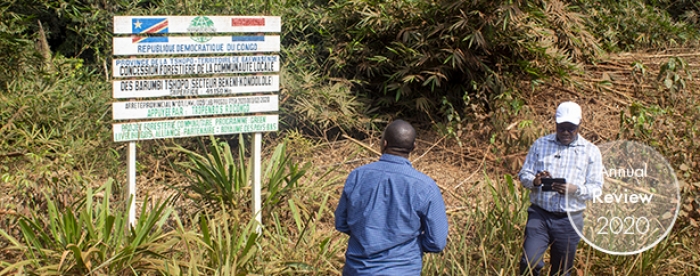News
Our stories ... ...

DR Congo - 28 April, 2021
As soon as communities in DR Congo received formal forest rights, they established new rules for forest management. The result: fewer trees are being cut, and the communities are earning more money.
Between 2017 and 2019, Tropenbos DR Congo assisted the communities of Barumbi-Tshopo, Bapondi and Bafwamogo in Tshopo Province to acquire formal forest rights. In February 2020 the communities formally received community forest concessions, covering around 90,000 hectares. They now have the exclusive right to use and manage these forests — in perpetuity. Village forest committees, consisting of democratically elected community members, are now in charge of all decisions regarding forest management.
Previously, decision-making power had been in the hands of traditional chiefs. This was seldom beneficial to communities. It was common for chiefs to sell standing trees to artisanal loggers from outside the community. This meant that a chief gave a logger permission to cut a certain number of trees, and received US$ 25 per tree in return, regardless of its size. The community did not have a say in the matter, and did not receive any of the money. Moreover, no one monitored what the loggers were actually doing in the field.
The three newly established management committees decided that this practice had to change. So, as soon as they received the formal concession rights, they called a meeting with loggers and other stakeholders, where they announced that all logging was suspended until a new system was in place. After the meeting, they wrote the main chief to inform him of their decision.
It didn’t take much time for the management committees to decide on a different system. According to the new rules, loggers now need to pay US$ 200 per cubic metre of sawn timber. Leftover timber can be used by the community. A community member accompanies the logger into the forest to calculate the exact volume after a tree has been felled and sawn into beams and planks. As a large tree may provide around five cubic metres of lumber, the community can earn up to US$ 1,000 per tree. Few loggers are willing to pay the new price, but for the village forest committees, this is not a problem. They get more money for fewer trees; that’s exactly what they wanted to accomplish. The money is used for community expenses, such as constructing a community building, or purchasing supplies for local schools.
Tropenbos DR Congo facilitated the three communities in the process of acquiring the concessions and developing management plans. Moreover, it provided training to the village forest committees on entrepreneurship and sustainable forest management. Even though the field staff of Tropenbos DR Congo had prepared the committees for their new task, they were positively surprised by the resoluteness of the committees’ decision-making. Clearly, the village forest committees were ready to take control of their own destiny.
The next step for Tropenbos DR Congo is to help more communities acquire forest rights and build capacity. It is estimated that more than 75 million hectares can potentially be awarded to communities, so there is still plenty of work to be done.

due for release in May 2021